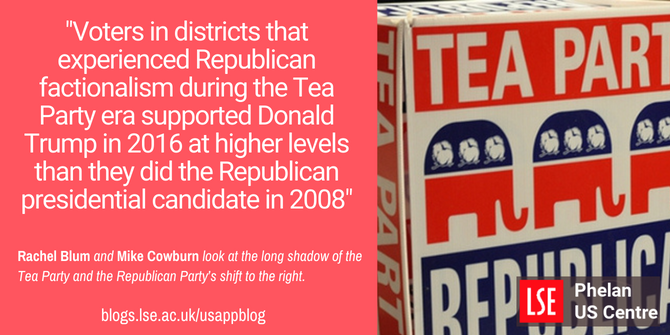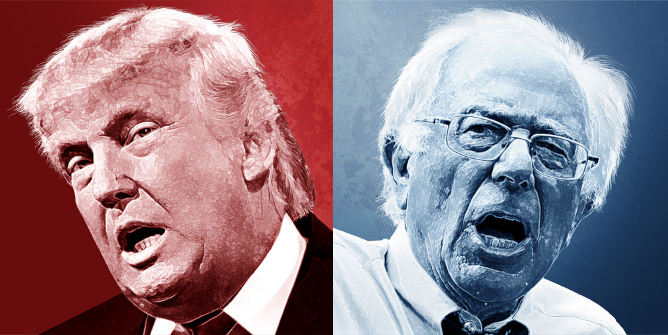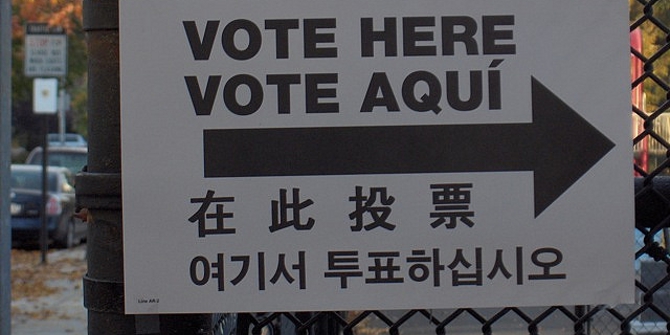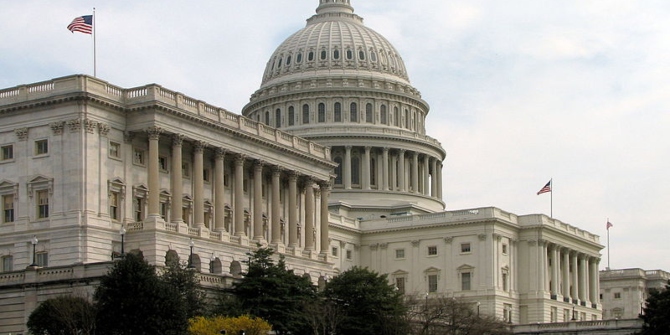
 The roots of Donald Trump’s rise and election victory are often traced to the Republican Party’s shift to the right by the Tea Party movement, beginning in 2009. In new research, Rachel Blum and Mike Cowburn look at the influence of the Tea Party on the Republican Party, finding that pressure from the movement’s groups on GOP congressional primary candidates between 2010 and 2014 helped move those districts further to the right. These districts in turn were more likely to support Donald Trump as the Republican presidential candidate in 2016 at greater levels than they did in the 2008 election.
The roots of Donald Trump’s rise and election victory are often traced to the Republican Party’s shift to the right by the Tea Party movement, beginning in 2009. In new research, Rachel Blum and Mike Cowburn look at the influence of the Tea Party on the Republican Party, finding that pressure from the movement’s groups on GOP congressional primary candidates between 2010 and 2014 helped move those districts further to the right. These districts in turn were more likely to support Donald Trump as the Republican presidential candidate in 2016 at greater levels than they did in the 2008 election.
In the past fifteen years, the Republican Party has become increasingly radical and moved ideologically to the right in both rhetoric and policy positions. The emergence of the Tea Party in 2009, following the election of Barack Obama as president, is often considered as representing a substantive shift in party orientation, and even to have paved the way for the Trump presidency. This rightward movement persists to this day, demonstrated by continued far-right factionalism in Congress, and by the strident pursuit of culture-war politics by Republican state legislators, governors, and presidential candidates.
Our research shows that the rightward movement of party elites and partisan supporters was fuelled by factional pressure from local Tea Party groups from 2010 to 2014. We find that congressional districts with multiple organized groups of Tea Party activists and at least one Tea Party-aligned primary candidate moved further rightward compared to other districts. In doing so, we reveal one way that local activists have retained power in an increasingly nationalized political environment by focusing on national issues.
We demonstrate that voters in districts that experienced Republican factionalism during the Tea Party era (2010–2014) supported Donald Trump in 2016 at higher levels than they did the Republican presidential candidate in 2008 compared to districts that did not experience factionalism. Contrary to classic accounts of party competition, the Republican Party appears to have gained popular support in presidential elections in places where a challenge within the party from another, farther right faction of the party was pronounced. We also show that elected officials in these districts also moved further rightward in their congressional voting behavior compared to their colleagues in other districts. Put simply, we find that local factionalism moved the party rightward at both the elite and mass levels.

“Tea Party” (CC BY 2.0) by sobyrne99
Local factional conflict caused rightward movement in the Republican Party
Using a carefully constructed experimental design (difference-in-differences), we show that the relationship between Tea Party factionalism and rightward movement is causal, not merely correlational. To do so, we constructed two sets of districts: one which was experiencing factionalism, and another was not, to act as a ‘control’ group. To ensure our design is not identifying radicalization because of other factors, we balanced our control and factional groups on a series of other explanations including demographic, economic, and partisan characteristics, and the emergence of the Tea Party.
Our results show that voters in districts experiencing Tea Party factionalism became more supportive of Republican presidential candidates between 2008 and 2016 (by roughly two percentage points) than those districts which did not have the same local Tea Party pressure. We find an even clearer Tea Party effect when looking at members of the US House of Representatives, whose roll-call voting behavior moved significantly rightward in districts that experienced factionalism.
Representatives in these districts became more conservative in their voting behavior between the 111th (2009–2011) and the 115th (2017–2019) congresses. The effect of this movement is larger than the average difference between Republican and Democratic representatives in the 115th Congress, where districts experiencing factionalism moved more than three times further rightward than those from districts that did not. We show that most of this movement is due to a replacement effect, where comparatively moderate representatives were replaced by more conservative Republicans.
Intra-party factions can increase polarization.
Persistent factionalism within the Republican Party appears to have exacerbated trends toward ideological extremism, underscoring the importance of looking closely at intra-party dynamics. Districts experiencing a critical mass of factional pressure from both activists and candidates shifted rightward between 2008 and 2016. These results were most pronounced when it came to elite behavior and suggest that intra-party strife over policy, practice, and adherence to democratic norms under Trump can be understood as a continuation of factional divisions that were exacerbated during the Tea Party era. This work helps us better understand the internal contours of power in the Republican Party. It also helps explain why we have yet to see a Tea Party parallel on the left, as progressives currently lack the organizational structure to execute a multi-district factional insurgency.
- This article is based on the paper ‘How Local Factions Pressure Parties: Activist Groups and Primary Contests in the Tea Party Era’ in the British Journal of Political Science.
- Please read our comments policy before commenting.
- Note: This article gives the views of the author, and not the position of USAPP – American Politics and Policy, nor the London School of Economics.
- Shortened URL for this post: https://bit.ly/46jtsay






